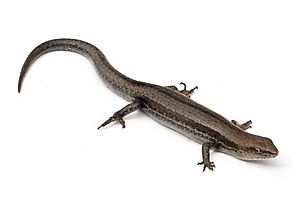Common garden skink facts for kids
Quick facts for kids Common garden skink |
|
|---|---|
 |
|
| Conservation status | |
| Scientific classification | |
| Genus: |
Lampropholis
|
| Species: |
guichenoti
|
| Synonyms | |
|
|
The common garden skink (Lampropholis guichenoti) is a small lizard often seen in Australian gardens. It's also known as the pale-flecked garden sunskink or penny lizard. These little reptiles are native to Australia and are quite common in many areas. They are a type of skink, which is a kind of lizard.
Contents
Where Do Garden Skinks Live?
Garden skinks are very common in suburban gardens. You can often spot them in cities like Adelaide, Melbourne, Perth, Sydney, and Brisbane. They live across most of Southern Australia, Tasmania, and parts of New South Wales.
Sometimes, garden skinks are also found in other countries. They have been seen in suburban gardens in Auckland, New Zealand. You might even find them in parts of the Eastern U.S., the Indian subcontinent, and South Africa. They have also been found in the Lüneburger Heide forest in Germany.
What Do Garden Skinks Look Like?
Garden skinks are small lizards. They can grow up to 14 cm long, but most are usually around 9 cm. On average, a common garden skink lives for about 2 to 3 years.
Their bodies are usually a brownish-black color. Sometimes, they might look a dark red when they are warming up in the sun. The lighter their color, the more active they tend to be. They have tiny, sharp teeth that help them easily slice through small insects. Even wild skinks are usually very calm. They rarely bite people if you touch or pick them up.
How to Tell Males and Females Apart
Female pale-flecked garden sunskinks have a yellowish or almost orange color on their belly. Male skinks, however, have a light gray color on their underside. Females are often a bit bigger than the males.
What Do Garden Skinks Eat?
Garden skinks are helpful animals to have around. They eat many different kinds of small creatures. Their diet includes crickets, moths, slaters, earthworms, flies, and caterpillars. They also enjoy grasshoppers, cockroaches, earwigs, slugs, small spiders, and ladybugs.
They can also eat some fruits and vegetables. But vegetables need to be cooked for the skink to eat them easily. Skinks especially love bananas and strawberries. However, you should never give them citrus fruits like oranges or lemons.
How Do They Hunt?
Garden skinks hunt by watching for movement. They rely on their prey moving to spot it. When hunting, they might hide and wait for food to come close. Or, if they are very hungry, they will actively chase their prey.
Once they catch something, they shake it strongly to kill it. Then, they swallow it whole. After a good meal, they often become more energetic and will hunt for a short while. A garden skink usually only needs one meal every 4 or 5 days. This makes them quite easy to care for if you have one as a pet. If you feed them worms, make sure to remove the soil from the worms first.
Where Do Garden Skinks Live?
Skinks like to hide in certain places. You can often find them under leaves, in long grass, or under rocks. These spots help them watch for prey without being seen. They also like to hide in logs, where bigger animals can't reach them.
Like most reptiles, common garden skinks are cold-blooded. This means their body temperature changes with the temperature around them. You might see them on top of rocks or warm paths in the morning. They do this to warm up their blood in the sun. Skinks prefer large areas with lots of leaves and soft soil. They are usually found in warm, dusty places that have many trees and tree stumps.
Who Hunts Garden Skinks?
The main predators of garden skinks are birds and cats. Even small birds, like robins, can be a danger to them. Larger lizards and snakes will sometimes try to eat them too.
A Clever Escape Trick
Like many other skinks, the common garden skink has a special way to escape danger. If a predator grabs its tail roughly, the tail can break off. The disconnected tail will twitch a lot for a while. This twitching grabs the predator's attention, giving the skink time to run away. This survival trick might seem painful, but it doesn't hurt the skink much. While it uses some energy, the skink's tail will eventually grow back to normal.
How Do Garden Skinks Have Babies?
Common garden skinks lay eggs. This means they are oviparous. They lay small, white eggs between summer and mid-autumn. A female skink usually lays about six eggs at a time.
Sometimes, many females will lay their eggs together in one spot. These shared nests can have as many as 250 eggs in total! They usually lay their eggs under a cluster of rocks. This helps keep the eggs safe from predators. The eggs hatch just a few weeks after they are laid. Most eggs are about 10 mm long.


